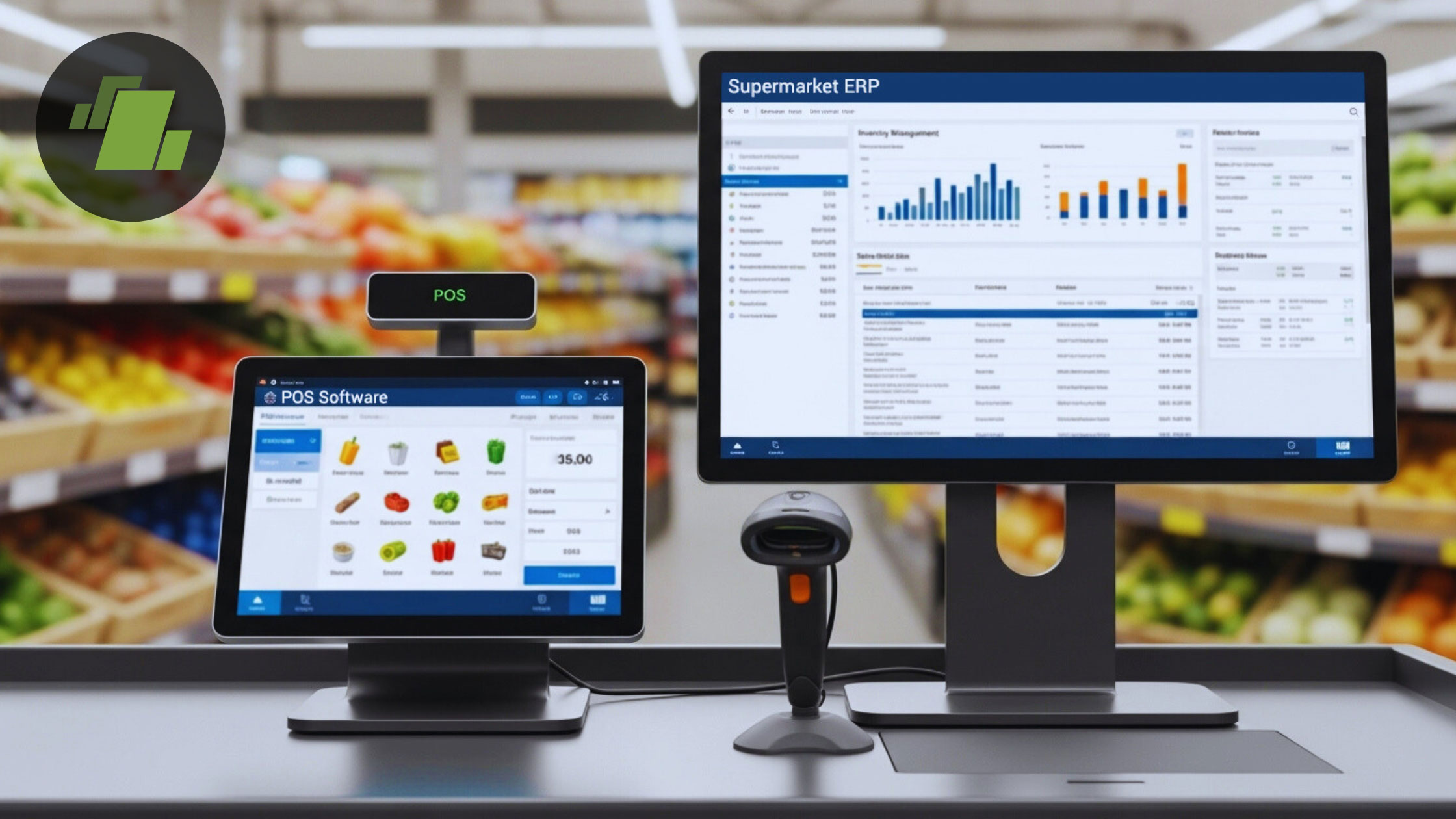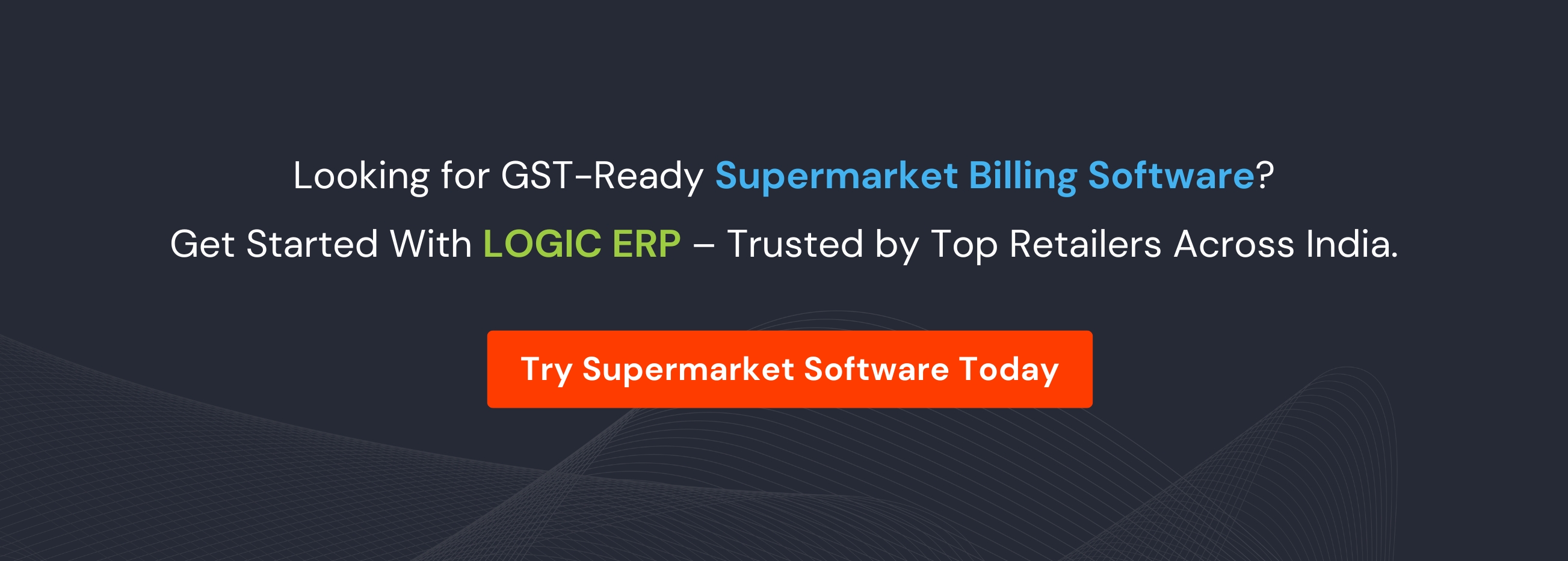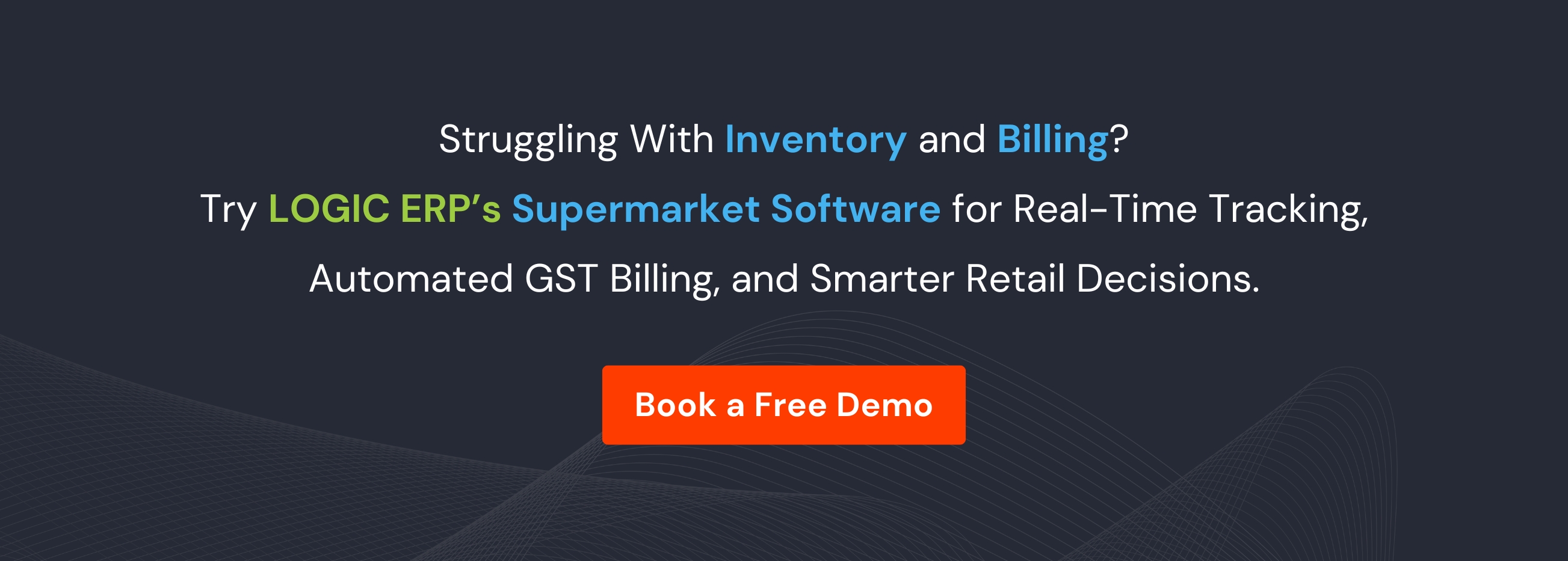How to Digitize Your Grocery Business with Supermarket ERP and POS Software


Summary
Supermarket software with advanced POS and billing capabilities enables retailers to streamline inventory, improve customer service, and ensure GST compliance. LOGIC ERP offers scalable supermarket POS software for end-to-end retail automation, including real-time stock tracking, barcode scanning, loyalty integration, digital receipts, and multi-store management. Whether you’re running a single outlet or a retail chain, upgrading to smart supermarket billing software can drive efficiency, reduce errors, and increase profitability.
Key Takeaways
-
Supermarket POS software ensures faster checkouts, barcode scanning, and digital payment integration, enhancing the customer experience.
-
LOGIC ERP supermarket software helps manage inventory in real-time across single or multiple store locations.
-
Built-in GST billing and compliance features reduce manual tax calculations and errors in financial reporting.
-
The solution enables centralized control over promotions, pricing, and loyalty programs for large supermarket chains.
-
Cloud-based supermarket software allows store owners to access reports, monitor sales, and control operations from anywhere.
-
Automating supply chain, vendor management, and purchase orders helps reduce stockouts and excess inventory.
-
Scalable and modular design of LOGIC ERP supports growing businesses, from small supermarkets to national retail chains.
A Complete Guide to Modern Retail Management
The grocery retail landscape is undergoing a digital transformation that’s reshaping how supermarkets operate, compete, and serve customers. With the global grocery POS systems market projected to reach $8.2 billion by 2028, implementing comprehensive supermarket ERP software and grocery store POS systems has become essential for business survival and growth.
Understanding Digital Transformation in Grocery Retail
Digital transformation in grocery retail involves integrating technology solutions to streamline operations, enhance customer experience, and drive profitability. Modern grocery business management software goes beyond simple point-of-sale transactions to encompass inventory management, supply chain optimization, customer relationship management, and financial reporting.
Why Grocery Stores Need Digital Solutions
Traditional grocery operations face numerous challenges that digital solutions can address:
- Inventory Management Complexity: Managing thousands of SKUs with varying expiration dates, seasonal demands, and supplier relationships
- Customer Experience Expectations: Shoppers demand seamless omnichannel experiences, from online ordering to curbside pickup
- Operational Efficiency: Reducing manual processes, minimizing waste, and optimizing staff productivity
- Data-Driven Decision Making: Leveraging analytics for better purchasing decisions, pricing strategies, and customer insights
- Compliance and Traceability: Meeting food safety regulations and tracking products through the supply chain
Core Components of Supermarket ERP Systems
A comprehensive supermarket ERP solution integrates multiple business functions into a unified platform. Here are the essential modules that modern grocery retailers require:
1. Advanced Inventory Management
Effective grocery inventory management software forms the backbone of successful retail operations. Key features include:
- Real-time Stock Tracking: Monitor inventory levels across multiple locations with automatic updates
- Lot and Serial Number Tracking: Ensure complete traceability for food safety compliance
- Expiration Date Management: Automated alerts for products approaching expiration to minimize waste
- Demand Forecasting: AI-powered predictions based on historical sales data, seasonal trends, and external factors
- Automated Reordering: Set minimum stock levels and automatic purchase order generation
- Multi-location Management: Centralized control over inventory across multiple store locations
2. Integrated Point of Sale (POS) Systems
Modern grocery store POS software goes far beyond basic transaction processing:
- Multi-channel Integration: Seamless processing for in-store, online, and mobile app purchases
- Customer Loyalty Programs: Built-in rewards systems and personalized promotions
- Payment Processing: Support for cash, cards, mobile payments, and emerging payment technologies
- Scale Integration: Direct connection with produce and deli scales for accurate pricing
- Staff Management: Time tracking, commission calculations, and performance monitoring
- Receipt Customization: Branded receipts with promotional offers and loyalty program information
3. Supply Chain Management
Efficient retail supply chain software optimizes vendor relationships and procurement processes:
- Vendor Management: Centralized database of supplier information, contracts, and performance metrics
- Purchase Order Automation: Streamlined ordering processes with approval workflows
- Receiving and Quality Control: Digital check-in processes with quality assurance protocols
- Cost Analysis: Track landed costs, including shipping, duties, and handling fees
- Supplier Performance Tracking: Monitor delivery times, quality issues, and pricing trends
4. Financial Management and Reporting
Comprehensive retail accounting software provides financial visibility and control:
- Automated Bookkeeping: Integration with POS and inventory systems for accurate financial records
- Profit Margin Analysis: Real-time visibility into product and category profitability
- Cash Flow Management: Monitor cash positions across multiple locations
- Tax Compliance: Automated tax calculations and reporting for various jurisdictions
- Financial Reporting: Customizable dashboards and reports for stakeholder communication
Benefits of Implementing Grocery ERP and POS Solutions
Operational Efficiency Improvements
Digital transformation delivers measurable efficiency gains across grocery operations:
Reduced Manual Labor: Automation of routine tasks like inventory counting, reordering, and price updates can reduce labor costs by 15-20%.
Faster Checkout Processing: Modern POS systems can reduce average transaction times by 30-40%, improving customer satisfaction and enabling higher transaction volumes.
Improved Accuracy: Automated systems significantly reduce human errors in pricing, inventory tracking, and financial reporting.
Enhanced Customer Experience
Today’s consumers expect sophisticated retail experiences that digital solutions enable:
Personalized Shopping: Customer data analysis enables targeted promotions and personalized product recommendations.
Omnichannel Convenience: Integrated systems support online ordering, curbside pickup, and home delivery services.
Shorter Wait Times: Efficient POS systems and queue management reduce checkout delays.
Loyalty Program Integration: Seamless rewards processing encourages repeat business and increases customer lifetime value.
Data-Driven Decision Making
Modern grocery analytics software transforms raw data into actionable insights:
Sales Trend Analysis: Identify top-performing products, seasonal patterns, and emerging customer preferences.
Inventory Optimization: Reduce carrying costs while maintaining optimal stock levels to prevent stockouts.
Pricing Strategy: Dynamic pricing based on demand, competition, and profit margin requirements.
Customer Behavior Insights: Understand shopping patterns to optimize store layouts and product placement.
Cost Reduction and Profitability
Digital solutions drive bottom-line improvements through various mechanisms:
Waste Reduction: Better expiration date management and demand forecasting can reduce food waste by 20-30%.
Energy Efficiency: Smart systems can optimize refrigeration and lighting based on occupancy and inventory levels.
Labor Optimization: Efficient scheduling and task management improve staff productivity.
Theft Prevention: Advanced inventory tracking and POS monitoring help identify and prevent shrinkage.
Key Features to Look for in Grocery ERP Software
When evaluating supermarket management systems, consider these essential capabilities:
Scalability and Flexibility
Your chosen solution should accommodate business growth and changing requirements:
- Multi-location Support: Manage multiple stores from a centralized platform
- Modular Architecture: Add functionality as your business needs evolve
- Cloud-based Deployment: Ensure accessibility and automatic updates
- Integration Capabilities: Connect with existing systems and third-party applications
Industry-Specific Functionality
Generic business software often lacks the specialized features grocery retailers require:
- Perishable Goods Management: Handle products with expiration dates and varying shelf lives
- Unit of Measure Conversion: Manage products sold by weight, volume, or piece
- Recipe and Kit Management: Handle prepared foods and product bundles
- Seasonal Planning: Accommodate fluctuating demand patterns throughout the year
Mobile and Remote Access
Modern grocery operations require mobility and remote management capabilities:
- Mobile POS: Process transactions anywhere in the store using tablets or smartphones
- Remote Management: Monitor operations and access reports from any location
- Field Staff Applications: Enable delivery drivers and merchandisers to update systems in real-time
- Customer Mobile Apps: Provide shopping lists, promotions, and loyalty program access
Advanced Analytics and Reporting
Transform data into competitive advantages:
- Real-time Dashboards: Monitor key performance indicators across all business areas
- Predictive Analytics: Forecast demand, identify trends, and anticipate customer needs
- Custom Reporting: Generate tailored reports for different stakeholders and requirements
- Benchmark Analysis: Compare performance against industry standards and historical data
Implementation Best Practices for Grocery Digitization
1. Comprehensive Needs Assessment
Before selecting software solutions, conduct a thorough analysis of your current operations:
Process Mapping: Document existing workflows to identify inefficiencies and improvement opportunities.
Stakeholder Input: Gather requirements from all departments, including management, staff, and customers.
Technology Audit: Assess current systems and infrastructure to understand integration requirements.
Budget Planning: Establish realistic budgets that account for software, hardware, training, and ongoing support costs.
2. Phased Implementation Approach
Large-scale digital transformations are most successful when implemented gradually:
Phase 1 – Core Systems: Start with essential POS and inventory management functionality.
Phase 2 – Integration: Connect existing systems and add complementary modules.
Phase 3 – Advanced Features: Implement analytics, customer engagement, and optimization tools.
Phase 4 – Expansion: Scale to additional locations and add specialized functionality.
3. Staff Training and Change Management
Employee adoption is critical for successful digital transformation:
Comprehensive Training Programs: Provide both initial training and ongoing education opportunities.
Change Champions: Identify enthusiastic staff members to advocate for new systems and help colleagues adapt.
Feedback Mechanisms: Establish channels for staff to report issues and suggest improvements.
Performance Monitoring: Track system usage and user satisfaction to identify additional training needs.
4. Data Migration and System Integration
Ensure smooth transitions from legacy systems:
Data Cleaning: Audit and clean existing data before migration to ensure accuracy.
Integration Testing: Thoroughly test connections between different systems and modules.
Backup Procedures: Maintain comprehensive backups throughout the transition process.
Parallel Operations: Run old and new systems simultaneously during transition periods to minimize disruption.
Choosing the Right Technology Partner: LOGIC ERP Solutions
When selecting a technology partner for your grocery digitization journey, consider solutions that offer comprehensive functionality, industry expertise, and proven implementation success. LOGIC ERP provides specialized grocery and supermarket management solutions designed specifically for retail food operations.
Key Advantages of LOGIC ERP Supermarket Software
Industry-Specific Design:
Built specifically for grocery and supermarket operations with deep understanding of retail food challenges.
Comprehensive Integration:
Seamlessly connects POS, inventory, accounting, and customer management systems.
Scalable Architecture:
Supports single stores to large supermarket chains with consistent functionality.
Local Support:
Dedicated implementation and support teams with grocery industry experience.
Continuous Innovation:
Regular updates and new features based on industry trends and customer feedback.
Implementation Support
LOGIC ERP offers comprehensive implementation services including:
- Business Process Analysis: Detailed assessment of current operations and optimization recommendations
- Custom Configuration: Tailored system setup to match specific business requirements
- Data Migration Services: Professional data transfer from legacy systems
- Training Programs: Comprehensive staff training on all system modules
- Ongoing Support: Dedicated customer success managers and technical support teams
Measuring Success: KPIs for Digital Transformation
Track these key performance indicators to measure the success of your grocery digitization efforts:
Operational Metrics
- Inventory Turnover: Measure how quickly inventory converts to sales
- Stockout Frequency: Track how often products are unavailable
- Checkout Speed: Monitor average transaction processing times
- Staff Productivity: Measure tasks completed per hour worked
Financial Metrics
- Gross Margin Improvement: Track profitability gains from better pricing and cost management
- Cost Per Transaction: Monitor the efficiency of transaction processing
- Working Capital Requirements: Measure improvements in cash flow management
- Return on Investment: Calculate the financial benefits relative to implementation costs
Customer Satisfaction Metrics
- Customer Retention Rates: Track repeat customer percentages
- Average Transaction Value: Monitor increases in customer spending
- Customer Complaint Resolution: Measure service quality improvements
- Net Promoter Score: Assess customer loyalty and satisfaction levels
Future Trends in Grocery Technology
Stay ahead of the competition by understanding emerging trends in grocery technology:
Artificial Intelligence and Machine Learning
AI-powered solutions are revolutionizing grocery operations through:
- Demand Forecasting: More accurate predictions based on multiple data sources
- Dynamic Pricing: Real-time price optimization based on demand and competition
- Personalized Marketing: Targeted promotions based on individual customer behavior
- Predictive Maintenance: Anticipate equipment failures before they occur
Internet of Things (IoT) Integration
Connected devices enhance grocery operations through:
- Smart Shelves: Automatic inventory tracking and restocking alerts
- Temperature Monitoring: Continuous monitoring of refrigerated products
- Energy Management: Optimized HVAC and lighting systems
- Customer Traffic Analysis: Heat mapping and behavior tracking
Advanced Customer Engagement
Next-generation customer experiences include:
- Augmented Reality: Virtual product information and navigation assistance
- Voice Commerce: Integration with smart speakers and voice assistants
- Social Commerce: Direct purchasing through social media platforms
- Subscription Services: Automated recurring purchases for regular customers
Conclusion: Transform Your Grocery Business Today
Digital transformation is no longer optional for grocery retailers who want to remain competitive in today’s market. Implementing comprehensive supermarket ERP software and grocery POS systems provides the foundation for operational efficiency, enhanced customer experiences, and sustainable profitability.
The key to successful digitization lies in choosing the right technology partner, implementing solutions strategically, and maintaining focus on continuous improvement. With proper planning and execution, grocery retailers can achieve significant improvements in efficiency, customer satisfaction, and financial performance.
Start your digital transformation journey today by assessing your current operations, identifying key improvement opportunities, and partnering with experienced technology providers who understand the unique challenges of grocery retail. The investment in modern ERP and POS solutions will pay dividends through improved operations, happier customers, and stronger financial performance for years to come.
Ready to digitize your grocery business? Contact LOGIC ERP today for demo and discover how comprehensive grocery management software can transform your operations and drive sustainable growth.
Frequently Asked Questions
1. What is supermarket POS software and how does it work?
Supermarket POS software is a point-of-sale system designed for retail grocery stores and supermarkets. It handles billing, barcode scanning, stock management, and customer transactions in real-time. Integrated with supermarket ERP software, it offers a complete retail solution for billing, inventory, GST, and reporting.
2. Which is the best supermarket billing software with GST support?
LOGIC ERP is one of the best supermarket billing software with GST, offering automated tax calculations, e-invoicing, and compliance with Indian tax laws. It also supports multiple payment methods, barcode billing, and real-time reporting.
3. Can supermarket software manage multiple store locations?
Yes. Advanced supermarket ERP software like LOGIC ERP allows centralized control over multiple supermarket branches. It syncs inventory, sales, and promotions across all stores, providing a unified management platform for growing retail businesses.
4. How does supermarket software help with inventory management?
Supermarket software tracks stock levels in real-time, sends low-stock alerts, manages expiry dates, and automates purchase orders. It reduces waste, prevents overstocking, and ensures shelf availability for fast-moving items.
5. Is cloud-based supermarket POS software better than offline systems?
Yes, cloud-based supermarket POS software offers remote access, automatic backups, real-time syncing, and better data security. It’s ideal for multi-location stores and modern retailers who want access from mobile, desktop, or tablet.
6. Does supermarket POS software support loyalty programs and digital receipts?
Absolutely. Most modern supermarket POS systems, including LOGIC ERP, support loyalty point redemption, membership management, and instant digital receipts via SMS or email.
7. How much does supermarket software cost in India?
The cost of supermarket software in India depends on store size, features required, and whether it’s cloud-based or on-premise. LOGIC ERP offers scalable pricing plans tailored to supermarkets of all sizes.




